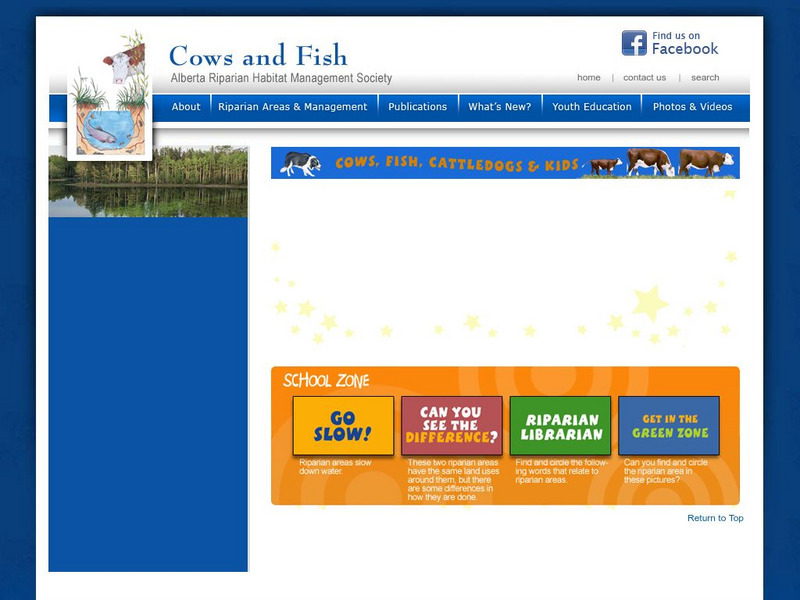Hi, what do you want to do?
Curated OER
Water Walk
Students conduct a visual survey to discover information about local land use and water quality; document their findings by mapping and profiling the water body; and use this initial investigation to raise questions about local land use.
Curated OER
Water, Water Everywhere, and Nary a Drop to Drink!
Students sing the continent song and locate oceans between the continents on a map. They read "They Earth is Mostly Ocean" and copy notes into their journals. They watch a demonstration of water and saltwater evaporated to see what is...
Curated OER
Testing the Waters
Learners study the quality of water by running chemical tests on the water. First, they measure pH, temperature, phospates, and nitrates in tap (drinking) water and an outdoor water sample. Then they post and evaluate the results of...
Curated OER
From Ground to Water
Students explore groundwater and issues relating to groundwater. They discus the problems involving groundwater. Students write a newspaper story addressing groundwater problems. They create a comic strip addressing groundwater...
Curated OER
The Water Cycle
In this worksheet on the water cycle, students read a short passage about the water cycle, located beneath a graphic organizer showing the cycle in pictures with labels.
Curated OER
Water Safety Checklist
Students discuss water hazards and how to stay safe. In this safety lesson, students read handouts and complete a water safety checklist to help themselves and their families.
Curated OER
Drop in the Bucket
Students study the sources for the water they use. They determine their town's major water supply and how many gallons per day does the population use.
Curated OER
Water Pollution Graphing Activity
Students describe and identify the link between land use activities within a watershed and water quality. They evaluate the quality of a "water sample" ( a bag of skittles), graph their results, and form a hypothesis about the land use...
Curated OER
Evaporation
Learners explain the process of evaporation using an activity that allows students to see the gradual disappearance of water.
Curated OER
What is Life Without Water?
Learners differentiate between how they use water in response to a need and how they use water for pleasure. They read books about water, participate in class discussion and illustrate their observations.
Curated OER
The Effect of Medications on Daphnia
Students explore how human beings affect the world's ecosystem by examining the affects of medication on daphnia, a small freshwater organism very sensitive to pollution. Students use a computer model to repeat the experiment and analyze...
Curated OER
Wildlife in Arkansas
First graders identify three species of wildlife in Arkansas. They discuss the environment in which the whitetail deer, raccoon, and beaver live in. They identify the footprints of each animal and discuss how the animals are harvested...
Curated OER
The Driving Force
Young scholars work in groups and note similarities and differences between their boats: size, shape, color, and unique features. They discuss 3 typical means of propulsion: propellers, sails, and paddles then share their charts with...
Curated OER
Our World
In this Earth Day coloring worksheet, students read a poem 'We've got the whole world around us in our hands.' Students then color the picture of the world in the hand.
Curated OER
The Water Cycle: Crossword Puzzle
In this water cycle worksheet, learners complete a 13 word crossword puzzle, using a set of given clues about the water cycle.
Curated OER
Bodies of Water: Word Search-ESL
In this worksheet on bodies of water, students find a set of 20 hidden words, solving a word search puzzle. Worksheet contains a link to additional activities.
Other
Minnesota Lakes, Rivers and Streams
This site gives information about Minnesota rivers and streams, stream flow information, and recreational information as well.
Nature Conservancy
Nature Conservancy: Planet Earth: Rivers and Lakes
A comprehensive exploration of rivers and lakes, their importance to biodiversity and to humans, how we use them, threats they face, and what is being done to conserve them.
Other
Alberta Riparian Habitat Management: Protecting Shorelines & Streambanks [Pdf]
Protecting Shorelines & Streambanks - Naturally explains the critical importance of healthy shorelines for preventing soil erosion and filtering out pollutants. It looks specifically at riparian areas, such as those in Alberta, which...
Missouri Botanical Garden
Missouri Botanical Garden: Freshwater Ecosystems
At this site from the Missouri Botanical Garden, you can learn about the wide variety of plant and animal life in or around fresh water ecosystems. Click on the links to "wetlands," "Ponds and Lakes," or "Rivers and Streams" to view...
Other
Alberta Riparian Habitat Management Society: Cows, Fish, Cattledogs and Kids!
Children will learn about riparian areas and their importance in maintaining balanced ecosystems in lands adjoining lakes, streams and rivers, as they play these colourful, interactive games.
Other
Chebucto: Soil & Water Conservation Society of Halifax
This site provides statistical information about rivers all around the world. Stats include mean discharge, drainage area, and length.
Other
Alberta Riparian Habitat Management Society: Riparian Soils [Pdf]
Riparian soils occur along the edges of a lake, stream or river. Pictures and diagrams in this fact sheet explain the importance of and composition of riparian soils.
Other
Pollution Probe: Mercury in the Environment [Pdf]
High levels of mercury exposure can cause birth defects, permanent brain or kidney damage, and/or death. This resource focuses on the impacts of mercury in the environment. Learn how mercury can reap havoc on lakes and other aquatic...
























